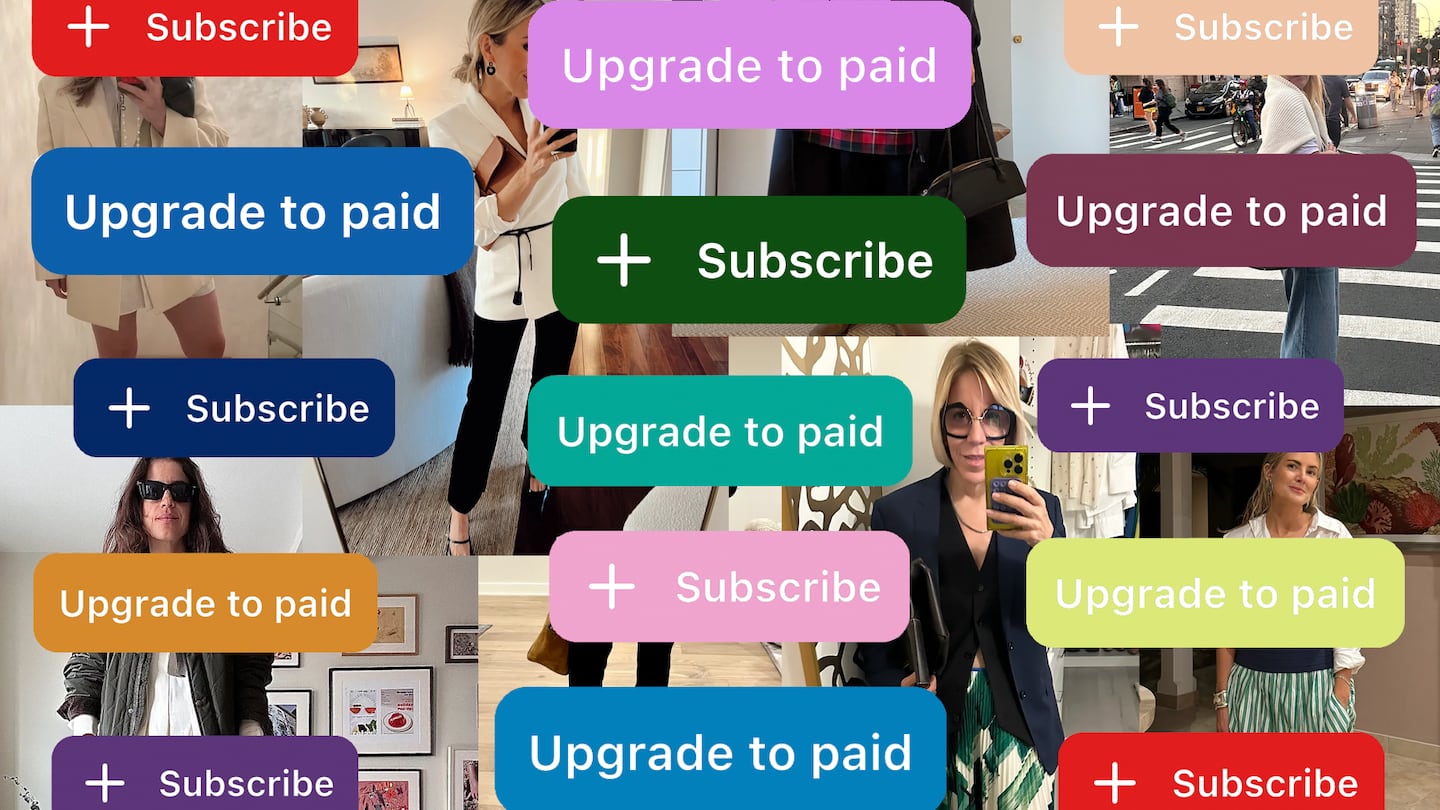
The Business of Fashion
Agenda-setting intelligence, analysis and advice for the global fashion community.

Agenda-setting intelligence, analysis and advice for the global fashion community.

It’s not just Vogue Runway and Cosmopolitan that are putting content behind the paywall.
A growing number of content creators are asking their audience to pay a monthly subscription fee for beauty tips, handbag recommendations and sale guides – often the same content they were giving away free not too long ago. They’re pitching followers on Substack newsletters, typically priced between $5 to $10 a month, or video on Patreon, where subscriptions range from as little as $1 a month to hundreds of dollars. In a sure sign the concept is taking off, Instagram rolled out a subscription feature in the US in 2022, which it has since expanded to other countries.
Fashion and beauty influencers are following in the footsteps of an earlier wave of journalists, historians and political commentators, some of whom earned seven figure annual payouts on these services when they first took off during the pandemic.
The trend is much newer in fashion, with fashion and beauty subscriptions on Substack up 80 percent in 2023 from the year prior. Many of those that have attracted the largest paid followings already had a loyal audience cultivated elsewhere. Longtime lifestyle blogger Joanna Goddard, for example, began her website Cup of Jo in 2007 and now has over 118,000 Substack subscribers. So does Leandra Medine Cohen, formerly of Man Repeller fame, who now writes a Substack called The Cereal Aisle about personal style with 111,000 followers. (They are still small creators by that platform’s standards; the top political Substacker has over a million subscribers.)
ADVERTISEMENT
In many ways, subscription content is a natural progression of how influencers monetise their followings. The audiences may be smaller, but creators are paid directly, cutting out middlemen such as affiliate link providers and brands (while introducing a new one, as the platforms take a commission).
Established influencers can also count on steady income from subscribers, without having to worry about the ups and downs of the social advertising market. They’re able to speak directly to readers who have literally paid to see them, rather than trusting the algorithm. Kim France, the founding editor-in-chief of Lucky magazine, whose Substack newsletter Girls of a Certain Age, charges $8 a month ($150 annually) for additional posts, said that offering a subscription has made it financially viable for her to publish essays and less shopping-centric posts.
That freedom is a double-edged sword – influencers have to trust their content is compelling enough that people will seek it out on an unfamiliar platform, and pay for it. And there’s a limit to how big subscriptions can get; after all, there are only so many $5 a month newsletters any one subscriber can afford, or has time to read.
But plenty of influencers will happily deal with all that in exchange for something that can be hard to find on Instagram or TikTok: control.
“As much as we love our brand partners, it’s gotten to the point now … you’re basically a scripted commercial actress,” said Jacey Duprie, a longtime influencer who launched a paid newsletter on Substack last year for $5 a month (or $50 annually). “For anyone, the goal is to just get back to the root of what it really means to be a content creator.”
From the earliest days of social media, there’s been a simmering tension between influencers and the platforms that made them famous. Apps like Instagram and TikTok are set up to command maximum attention, but can be agnostic about which creators receive those eyeballs, or whether they can profit from it. Countless creators have seen their audiences obliterated by tweaks to the algorithm or a pivot to video.
“The social platforms are building tools to maximise time spent on those platforms. Sometimes those are in service of creators, others they are actually in direct conflict,” said Rory Brown, the chief brand officer at Patreon. “There is this growing realisation of how much of the distribution is actually out of the hands of the creators.”
Relying on brand partnerships can have its ups and downs; they’re not guaranteed and the number coming in can fluctuate based on the time of year or how healthy a brand’s marketing budget is that quarter. And with affiliate links, influencers are pressured to post only about retailers they can link to, or around events like Black Friday.
ADVERTISEMENT
Subscriptions alleviate some of the need to constantly be selling to their audiences, a welcome shift for followers burnt out on ad-clogged feeds. For Harling Ross Anton, who charges $6 a month (or $60 annually) for a subscription to her Substack newsletter Gumshoe, the income she earns from subscriptions allows her to have a no affiliate links policy for her newsletter, making it easier for her to share one-off vintage finds.
“I don’t have to filter anything through the prism of different goals besides precisely what I want to write about,” she said.
Still, there’s downsides. Creators still have to worry about the content they’re appearing next to — technology writer Casey Newton left the platform earlier this year, saying that Substack had allowed writers that shared Nazi sympathies to publish on the platform. (Substack, for its part, removed five of the contested publications from its platform shortly after.)
And influencers who build up a subscriber base on platforms like Patreon or Substack are still ultimately cultivating their audience on a platform they don’t own, just as they are on Instagram. They also take a cut of their earnings; Substack takes 10 percent and its payment provider takes another, smaller chunk. For many influencers, the income they’re making via subscriptions pales in comparison to what brands are willing to pay. Influencer Merritt Beck, who offers a monthly subscription on Instagram, said that while the subscription income is nice to have, it’s not her primary revenue stream — and doesn’t necessarily remain consistent from month to month.
“There can be a drop off; people may sign up just to see one thing and then cancel right away so they don’t have to pay for the next month,” she said.
“The goal is to just get back to the root of what it really means to be a content creator.”
Paying subscribers, too, are more likely to be actual fans of an influencer and their content — and less prone to leaving hateful comments. Because content behind a paywall has limited access, it can’t be found through a Google search, and is something of a safer space to share the more personal details that followers often crave.
Beck launched her own paid channel on Instagram for that reason, charging followers $5 a month for bonus content like recaps of dates she goes on or a video tour of her apartment.
“We often tell people, the things you’re doing that are more behind-the-scenes, that’s really good to paywall,” said Christina Loff, the head of lifestyle partnerships at Substack. Loff added that it’s important for influencers to keep some content in front of the paywall, which can serve as marketing for their paid offering. Posts featuring affiliate links, too, should usually be kept free to access, as influencers will benefit from a larger audience having access to them.
ADVERTISEMENT
For that reason, Beck made the choice to keep the more fashion-oriented content, including styling tips, capsule wardrobe guides and more, that she’s offered for years on Instagram and her website for free.
“I positioned it that way that like the people who have followed me a long time, if you don’t want to pay, nothing will change,” she said. “This is just for people who are super fans, who really want to know what I’m up to behind the screen.”
Influencers with so-called super fans will have an easier time making the transition to a subscription-based model, as they’ve already baked-in a certain amount of goodwill with their would-be subscribers. To get readers on board, however, creators should be honest and upfront about why they’re making the transition.
France, who had published her content on a blog for a decade before making the shift to Substack with content behind a paywall, explained her rationale behind launching a paid tier and why it was necessary at this point for her to continue publishing the content they had been used to.
“Some people went away, but mostly, the readers were very supportive,” said France. “There is an understanding that this is the stage we’re in, that if you want content, you have to pay.”
As more followers come to that conclusion, platforms are responding with new ways for influencers to make subscriptions feel worthwhile. Some influencers will offer special benefits for subscribers, like a one-on-one Zoom styling session for those willing to pay extra. Substack offers subscriber-only chats, while Patreon allows creators to sell merchandise via their platform.
But perhaps the most significant shift is that subscriptions offer influencers more freedom. With this as a stable revenue stream, they can be choosier about what brand partnerships to undertake, and less reliant on affiliate income. Brands and social platforms, too, may need to sweeten their deals to make them more appealing to a choosier influencer.
“That’s the goal for anyone that is doing paid right now, to provide themselves with a supplement for having to take on as many sponsorships,” said Duprie.
Still, launching a subscription product ups other stakes for influencers. Just as brand partners can demand a certain result when partnering with a creator, paid subscribers can as well — and social media users are rarely quiet when displeased.
“When you’re taking money out of people’s pockets, you have to deliver on what you’re promising your audience,” Duprie added. “Otherwise, you’re going to lose them.”
Chiara Ferragni’s legal troubles and tainted image are a sign the pendulum is swinging from influencer-led marketing back to traditional media.
In 2022, brands spent more than three times the amount than 10 years prior to acquire each customer through marketing. Jennifer Piña, vice president of strategic partnerships at social commerce platform MagicLinks, shares why influencer marketing remains a powerful investment.
Influencer trips have come roaring back post-pandemic, sometimes to an opulent degree. A growing number of brands are toning down their events to deepen creator relationships without a PR headache.

Diana Pearl is News and Features Editor at The Business of Fashion. She is based in New York and drives BoF’s marketing and media coverage.
Calvin Klein’s chief marketing officer Jonathan Bottomley speaks to Imran Amed about the strategy behind the brand’s buzzy Jeremy Allen White-fronted campaign.
Often left out of the picture in a youth-obsessed industry, selling to Gen-X and Baby Boomer shoppers is more important than ever as their economic power grows.
This month, BoF Careers provides essential sector insights to help PR & communications professionals decode fashion’s creative landscape.
The brand’s scaled-back Revolve Festival points to a new direction in its signature influencer marketing approach.